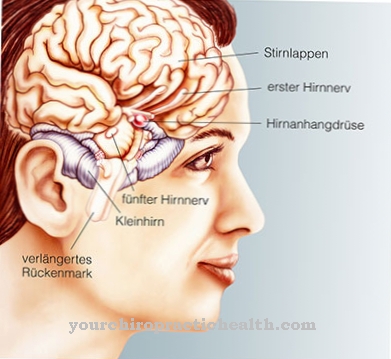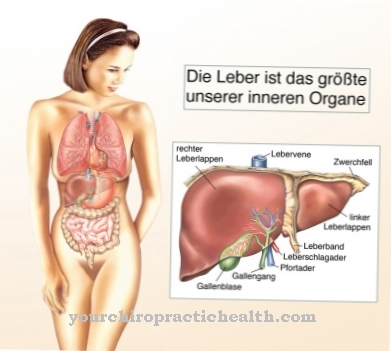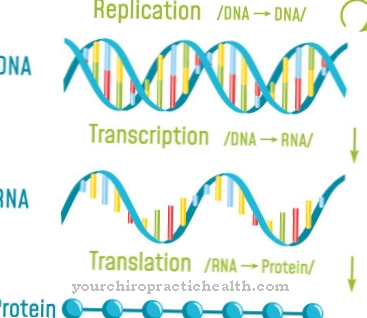Carbon monoxide poisoning can happen unnoticed and is life-threatening. The gas displaces the vital oxygen from the blood. Badly maintained ovens are the number one cause of carbon monoxide poisoning.
What is carbon monoxide poisoning?

© Peter Hermes Furian - stock.adobe.com
A Carbon monoxide poisoning is an intoxication with the gas carbon monoxide or technically carbon monoxide. The term carbon monoxide intoxication is therefore defined in terms of medical terminology. The poisoning can occur as an acute life-threatening crisis or as chronic poisoning with no obvious symptoms.
Carbon monoxide is a colorless gas with no odor. The substance consists of a carbon atom that is linked to an oxygen atom. The chemical name is CO (C: carbon, O: oxygen). The molecule is structurally similar to oxygen (O2: 2 oxygen atoms per molecule).
The toxic effect of carbon monoxide is ultimately based on this. Instead of oxygen, the gas binds to physiologically important structures in the metabolism. There the vital breathing gas is displaced and carbon monoxide poisoning occurs.
causes
Carbon monoxide poisoning is caused by a blockage of the red blood pigment (hemoglobin), which hardly absorbs any oxygen. This oxidizing agent can no longer or only insufficiently be carried to the place of consumption.
The result is an oxygen shortage in the organs. Carbon monoxide causes double stress for the muscle cells: They have an internal transport protein for oxygen, the myoglobin, which is similar to hemoglobin. The carbon monoxide also works here in the same way.
In addition, carbon monoxide suppresses energy production ("combustion") in all body cells very directly. This is known as internal suffocation and is a lesser known cause of carbon monoxide poisoning.
An increased concentration of carbon monoxide in the air can have several causes:
1) Incomplete combustion: poorly drawing coal, wood or gas stoves, Car and industrial emissions, fires
2) Natural concentration peaks in caves and mines
Both causes usually lead to accidents. However, some people use car exhaust as part of a suicide attempt by carbon monoxide poisoning.
Symptoms, ailments & signs
The symptoms of carbon monoxide poisoning depend on the concentration of the gas in the air and the length of time that someone is exposed to the poison. Symptoms range from moderate dizziness to death from lack of oxygen.
Based on an indication of particles per million (ppm) in the breath, approximate limit values for the occurrence of symptoms can be established in the case of carbon monoxide poisoning. At 35 ppm, dizziness and headaches only occur after several hours. Above 200 ppm, judgment can also be clouded and headaches come on more quickly. At 400 ppm, a very severe headache occurs within two hours.
From 800 ppm, cramps, nausea and loss of consciousness occur within two hours. The heart rate increases from a concentration of 1,600 ppm, whereby death can occur after a few hours. At 3,200 ppm, death can be expected within half an hour. From 6,400 ppm, seizures add to the symptoms. Death occurs within twenty minutes.
At 12,800 ppm, a few breaths will faint and death within minutes. In children, sick and old people, however, lower concentrations of carbon monoxide in the air are sufficient to trigger severe symptoms.
Diagnosis & course
Carbon monoxide poisoning manifests itself with symptoms such as nausea, headache and irregular breathing ("Cheyne-Stokes breathing"). A pink coloration of the skin is typical. These complaints threaten even at a concentration of 0.03% of the gas in the air. This value can already be achieved in large cities with high traffic volumes.
In more severe cases, convulsions and eventually loss of consciousness occur. The doctor shows the hemoglobin-bound carbon monoxide directly on the blood count. Severe acute and chronic carbon monoxide poisoning can lead to serious consequential damage to the nervous system and muscles.
Even a concentration of 1% carbon monoxide in the ambient air causes death to occur within a few minutes. Because hemoglobin binds the poison gas 200 times more strongly than oxygen and therefore quickly accumulates in the blood. Therefore, even low concentrations lead to carbon monoxide poisoning.
Complications
Carbon monoxide poisoning is a very serious burden for the human body. If this poisoning is not treated in time or if it lasts for a longer period of time, it can lead to a loss of consciousness or, in the worst case, death of the patient. For this reason, very quick treatment is necessary for carbon monoxide poisoning.
Those affected primarily suffer from acute shortness of breath and also from headaches. Furthermore, the shortness of breath can lead to panic attacks or sweating. Failure to stop inhaling large amounts of carbon monoxide will usually result in unconsciousness.
The patient can be injured by falling. If there is no rescue afterwards, the person concerned dies. The internal organs and nerves are also damaged by carbon monoxide poisoning, so that irreversible consequential damage can occur even after a rescue. It is not uncommon for carbon monoxide poisoning to lead to psychological complaints.
There are no further complications with the treatment itself. However, it does not always lead to a positive course of the disease. Life expectancy may be reduced by carbon monoxide poisoning.
When should you go to the doctor?
If someone suspects carbon monoxide poisoning among friends, the emergency doctor must be called immediately. It is a life threatening situation that requires immediate action. Immediate emergency medical care can avoid or minimize permanent consequential damage. In addition to acute carbon monoxide poisoning, chronic carbon monoxide poisoning can also occur.
The symptoms of chronic carbon monoxide poisoning last for several weeks. The cause must be searched intensively. The poisoning must be handled properly. Possible sources of carbon monoxide exposure can be clogged chimney flues or a garage that has not been adequately ventilated.
Treatment & Therapy
Carbon monoxide poisoning requires immediate expulsion of the toxic gas from the blood. In addition, the patient experiences hyperbaric oxygenation. This is artificial respiration with 100% oxygen.
In the simplest case, it is administered through a breathing mask, sometimes the patient is also intubated. A tube is a fixed tube in the windpipe, which is inevitable at the latest when the patient becomes unconscious. Hyperbaric chambers are a very effective, fast-acting method that, unfortunately, will not be available everywhere.
Patients must be constantly monitored so that the doctor can intervene immediately in the event of cardiovascular complications. The check also includes the blood values in order to clarify the detoxification status. In addition, bicarbonate (soda) must be given by infusion if the blood is too acidic.
Follow-up treatment may require rehabilitation aimed at alleviating the sequelae. In the case of suicide attempts, the psychiatrist also devotes himself to the patient after surviving carbon monoxide poisoning.
You can find your medication here
➔ Medicines for headaches and migrainesOutlook & forecast
The prognosis is different for carbon monoxide poisoning. If there was no carbon monoxide warning device in their home, caravan or garage, they would not notice the odorless poison. Often it flows from defective gas heaters or a charcoal grill placed in the apartment that is still glowing. Just a few breaths of the smoke gas are enough for unconsciousness to occur. Just a few more breaths inevitably lead to death.
If they are rescued at the right time or if the carbon monoxide alarm works, the outlook is better. In many cases, for example, campers or visitors to a shisha bar could be saved in good time if the carbon monoxide levels were very high. The patients must be supplied with oxygen immediately so that they do not die from the smoke gases they have already inhaled. Due to the duration of the amount of CO2 that can be exhaled in the open air, it is not sufficient to simply bring the person affected into the fresh air. Those affected must be ventilated with oxygen immediately. In this way, the poisoning process can be interrupted and revised.
In the case of carbon monoxide poisoning, the vital transport of oxygen through the hemoglobin is blocked. If it stays that way, the chances of survival are poor. The heart and brain are damaged by carbon monoxide poisoning. On average, 10 percent of all people who have accidentally become carbon monoxide poisoned die. The remaining 90 percent of those affected could be discharged after clinical treatment.
prevention
Carbon monoxide poisoning can be prevented with just a few security measures. Since the most common cause is inadequate incinerators in rooms, a professional should regularly perform maintenance here. Measurements of the MAK values (maximum workplace concentration) in the company give an early warning of imminent danger.
In some professions (road construction, fire brigade), long-term exposure cannot be avoided. Respiratory protection masks should be worn here if necessary. Otherwise, avoid locations with high risk of carbon monoxide poisoning.
Aftercare
In most cases, those affected by carbon monoxide poisoning have no special follow-up options available. First and foremost, the cause of this poisoning must be clarified so that it cannot recur. The further course depends very much on the severity of the carbon monoxide poisoning, so that no general prediction can be made.
Typically, carbon monoxide poisoning is relieved by breathing in oxygen, which can be done in a hospital or through an emergency doctor. In severe cases, a longer stay in a hospital is necessary to alleviate the symptoms of this poisoning. In any case, the person affected should take it easy and not exert themselves. Physical or stressful activities should be avoided in any case.
For some people, a psychological examination and counseling is necessary due to carbon monoxide poisoning. This is especially true if it was a suicide attempt. Intensive and loving conversations with parents or with relatives and friends also have a positive effect on the further course of the process. In many cases, carbon monoxide poisoning reduces the life expectancy of those affected.
You can do that yourself
First and foremost, in the event of carbon monoxide poisoning, the person concerned must be brought to safety and removed from the poisoned room. A direct supply of oxygen or, in an emergency, mouth-to-mouth resuscitation can prevent further complications or, in the worst case, death of the patient. However, an emergency doctor should always be called in the event of carbon monoxide poisoning. This can take care of those affected and make them more stable. Usually a short stay in hospital is necessary.
The acidification of the blood with carbon dioxide must also be controlled and possibly avoided. In some cases, carbon monoxide poisoning can also cause long-term harm, so patients rely on the help of friends and family.
If the carbon monoxide poisoning occurs as a result of a suicide attempt, the person concerned must undergo psychological treatment. A stay in a closed clinic may also be necessary. Help from family and friends is also very important with psychological complaints and can lead to faster healing. In an acute emergency, the patient must also be calmed down and placed in a stable position until the emergency doctor arrives.

.jpg)











.jpg)

.jpg)
.jpg)











.jpg)